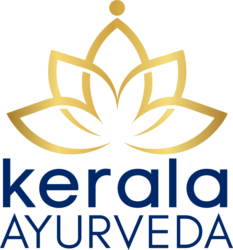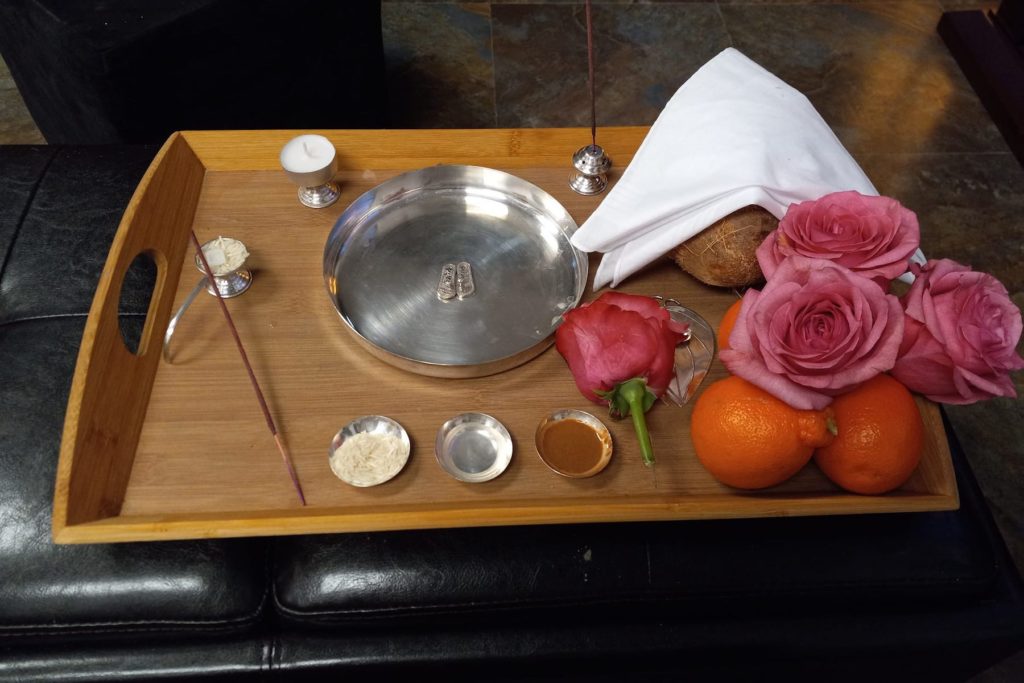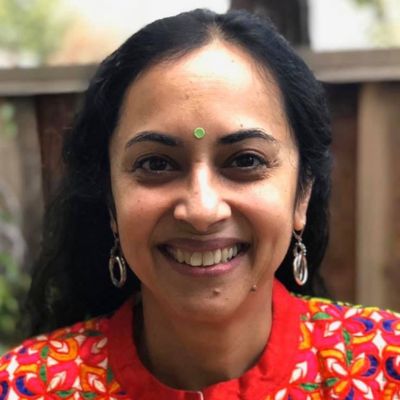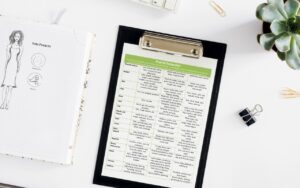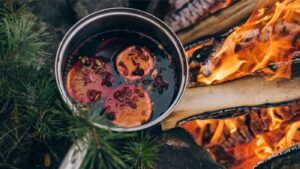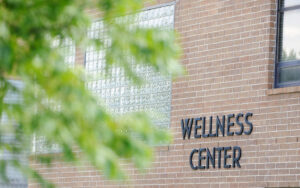Kerala Ayurveda Academy offers Panchakarma Technician training for Ayurvedic students of all levels. Panchakarma is Ayurveda’s traditional bodywork therapy system and detoxification methodology. There is a growing demand for deeper healing in the U.S. to address the widespread chronic ailments people are facing. We hope our graduates can share this needed practice with those seeking deep healing.
To learn more about how our graduates are applying their Panchakarma training, we interviewed Andrew Nunberg (Andy), Art of Living Teacher and Massage Therapist. Andy shared his journey, how the training has benefited him, and his tips for prospective students of Panchakarma.
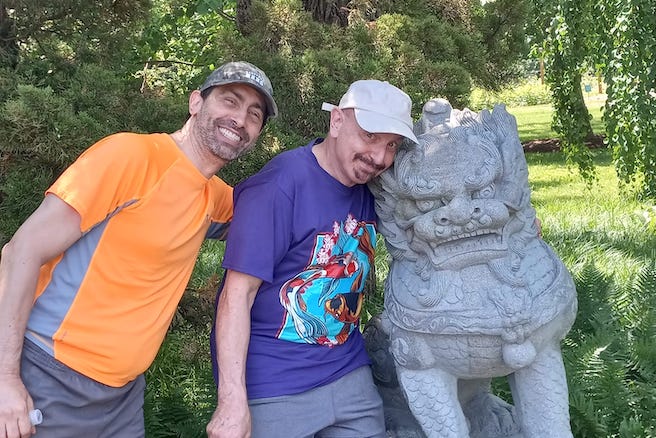
Setting up an Ayurvedic wellness practice
Tell us about your career path
I am the owner of Hands, Heart & Soul, and my husband, Norm, is an osteopathic physician. In 1995 I completed my Ph.D. in Biology with a thesis in Plant Molecular Biology and worked as a Scientist and Bioinformatician. Then went on to become a full-time meditation teacher with the Art of Living Foundation. Norm’s practice includes some Acupuncture, TCM (Traditional Chinese Medicine), Ayurvedic principles, and Nadi Pariksha, which he studied through the Transcendental Meditation movement. He also makes dietary and lifestyle recommendations and advises Ayurvedic bodywork therapy.
How did you get into yoga and meditation?
I did my first Art of Living course in 1998 because Norm recommended it, and I really liked it. In 2005 I became a teacher after I was laid off from a project in Bioinformatics. So, I decided to teach full-time since Norm was supporting me. Through the Art of Living Foundation, I teach two meditation courses (SKY Breath and Sahaj Samadhi) and lead retreats. Gurudev Sri Sri Ravi Shankar, the founder of Art of Living, has talked about the effects of SKY on the Pancha Vayus and other effects on physiology from both an Ayurvedic and Allopathic perspective over the years.
At first, I did not notice any obvious benefits of SKY and Sahaj since I was doing it regularly, but when I had skipped a few days, I noticed immediately that I had much less energy and I was more susceptible to negative emotions. The Vedic wisdom I was exposed to in Art of Living, like knowledge of the gunas and doshas, helped me to avoid negative thinking by not taking others’ actions/behaviors/words so personally.
What inspired you to learn Ayurveda and bodywork therapy?
In 1998, I had my first Panchakarma here in St Louis. My fondest memory was the pizhichiI treatment at the end. My least favorite memory was ingesting ghee during snehapana. I had to eat rice with it, it was the only way to get the ghee down!
Then I was exposed to Ayurveda here and there through Art of Living retreats and courses. The shift came when I was going to end my full-time activities with the foundation and wanted to start looking to expand my career as someone promoting Vedic Knowledge.
In 2018 I received training in Marma Chikitsa through the Art of Living Foundation and was exploring all the legal requirements to practice. This is when it became clear I needed to have a “license to touch” in the state I reside. I then enrolled in Massage Therapy school and by 2019 I was a licensed massage therapist. As it so happened, during my time in massage therapy school, Art of Living had a 3-week residential program to teach Ayurvedic bodywork: Abhyanga, Shirodhara, Kati Vasti, Karna Purna. I was fortunate enough to be able to use this time towards my massage therapy certification.
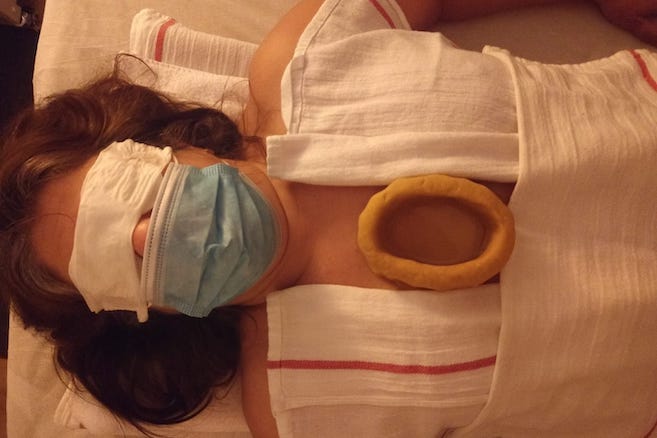
How Panchakarma training enhances your current practice
What is the nature of your current practice and why Panchakarma training?
As soon as I finished my certifications, I started to set up my practice within my husband’s medical practice. Unfortunately, this was right as Covid-19 started to hit and I had to scale back and employ health measures. I was primarily giving shamana treatments and not really getting into planning a course of treatment for the rogis coming to me. Although I was aware of checking for agni and ama status, I was not as confident about making recommendations at that time.
I wanted to add to my knowledge and expertise, but I was now working full-time at my husband’s practice as the office manager, so I needed something that was remote. My Marma trainer, Revathi Ragavhan, suggested that I check out Kerala Ayurveda. She teaches an amazing Ayurvedic Skin and Beauty class at Kerala Ayurveda. There was a PK Technician training that was mostly online with a couple of in-person visits making it possible for me to receive the training. I did check out other online training but to be honest, but was not impressed. No Vaidya was associated with those “schools” and I did not see anything indicating I would be learning traditional Ayurveda.
What were some of the takeaways from your Panchakarma training with KAA?
It was nice to see other ways of doing the treatments, like Abhyanga or Shirodhara. Also, the use of different lentil-based flours and their properties for external Vasti. The basic tools of assessment of agni, ama, and the doshas were great. Instead of just addressing the main complaint of the rogi, I now do more assessments, customize the treatment, and give instructions beforehand to help with agni and ama.
For example, a rogi came to Norm for help with his health situation through Ayurveda. Part of his problem was amla pitta, along with other pitta issues, but he had significant ama and agni imbalances. So, the decision was to do udvartana and valuka pinda swedana first to address ama and agni and then work on the rogi’s pitta issues. After those two treatments, the rogi reported all symptoms had reduced significantly.
How do you currently position your bodywork therapy practice?
I’ve enhanced my practice, strengthened techniques, and added to current therapies. Relearning Vastis was extremely helpful, and now I offer the following therapies:
● Abhyanga
● Shirodhara
● Swedana
● Marma
● Udvartana
● Kati Vasti, Griva Vasti
● Pinda Sweda
My practice focuses on Ayurvedic wellness supplemented with massage therapy. And I am in contact with two AD students who I can refer to for PK planning for my rogis. I help clients with removing toxins (ama), correcting digestive fire (agni), and clearing and stabilizing their system’s channels. At current, I am not offering full Panchakarma as I work to align North and South Indian Ayurvedic practices. It helps that Norm does pulse diagnosis. For instance, someone had fibromyalgia but did not mention lower back pain which Norm detected. The person sleeps at 2 am, which we are trying to correct! I am likely to collaborate with an Ayurvedic practice to get clients to do a full assessment, so that appropriate bodywork therapy and formulations can be advised. Still having responsibilities at Norm’s medical practice, I only take appointments, no walk-ins.
How do you take care of yourself?
I do my best to do yoga asanas on a regular basis and have my daily meditation practice which is essential in rejuvenating the system after a long day of treatments. More importantly, I have developed good relationships with other massage therapists, and we trade treatments.
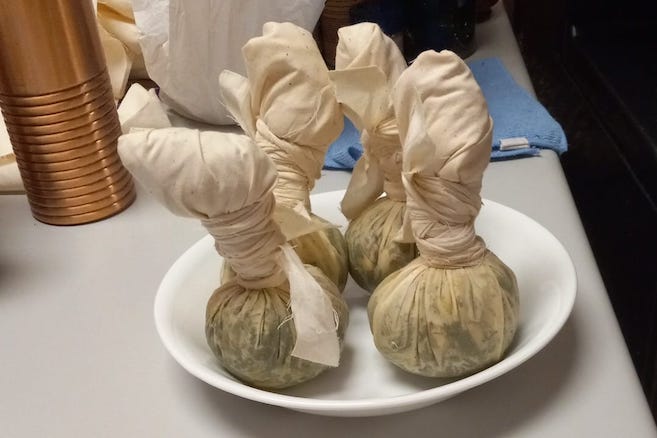
Knowledge of internal cleansing (Shodhana) therapies
When to intervene
Norm had a Rogi with amla pitta (hyperacidity), migraine, pitta imbalances, and obvious signs of Ama and Mandagni. He could barely ingest any formulations and had neck pain. Valuka Pinda Sweda combined with Udvartana (less unctuous therapies) for a couple of days helped his symptoms subside.
A customized plan
A rogi who is Kapha dosha-dominant wanted treatments after a trip to India. Although he initially was asking for something to pacify his Vata, after talking to him further I decided to go with udvartana as he expressed issues that were more Kapha/ama related. This rogi also likes to do intermittent fasting and other types of fasting like oil only or just water. He does not eat regularly or at the appropriate times either. I made recommendations for eating habits.
A knowledge of formulations
Although knowing about the various medicated oils is both helpful and fascinating, I am not at the point where I can purchase large quantities. In certain cases, I can have the rogi purchase oil from the KA store in advance. One formulation which I am finding very versatile is Ksheera Bala Thailam. We practiced making it in class and I have made it a few times. Many people I see are suited for that oil as they need both nourishment and nervine action. I would like to see what other oils are easy to make that would also be of use in my practice.
What would you recommend to someone setting up a massage and Panchakarma therapy practice?
What to study
In about any state, you are going to need to be a massage therapist to do all the treatments. There are programs in community colleges as well as private institutions, many are around 8 months in length.
Mukha (face) and Pada (foot) abhyangas with marma facials
Depending on the community you plan to serve, often people do not know about Ayurveda and the various body treatments. I highly recommend something that doesn’t take long, is easy to do, and has a significant impact. Face/foot abhyanga are easy to implement and you can add marma chikitsa as well. Some folks are not sure about the use of oil, so this gives them a manageable experience.
Space and supplies for bodywork therapy
A portable massage table will get you far and is vital. In terms of space, a standard room (10×18) will work. Although in my practice my room is smaller, I still make it work.
For Shirodhara I made an investment in a ShiroBliss machine after several months of the standard hanging pot and collecting oil. I do like the convenience of the ShiroBliss and you end up using about the same amount of oil.
I also purchased a Steamy Wonder, a tent that can be placed over the massage table for baspa swedana. My setup doesn’t have the space to do swedana in a chair. Steam tents for chairs are less expensive and if you have the space you may want to go that route.
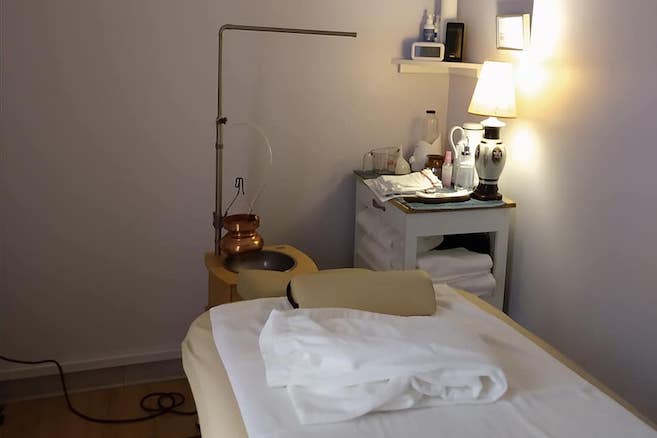
Offer and attend events
Go to events. Bring a chair, or table, and do something, anything. Honestly just teaching about Ayurveda is huge because most folks just don’t know. What I see in my area is more need for education and understanding the value of what we do, beyond just the experience of a treatment. Because of our experience with Covid and lockdowns, doing online classes makes reaching out easier.
Marketing tips
Word of mouth is where most bodywork therapy people get the most bang for their buck. Build relationships with other entities, businesses, civic organizations, churches, and events. You can donate back with profit sharing for a cause. Network with other Ayurvedic people, for instance, set up an Abhyanga camp with another practitioner.
As any small business owner will tell you, always have a business card on hand. Having a website is necessary these days and there are resources that make it easy to create one yourself. Creating positive mutually beneficial relationships is another must for me. Now that I have more time, I am looking more into this. Recently I met someone who sells skin care products, and we traded services. Now we are collaborating on an event where we bring ayurvedic bodywork therapy to their events. People are extremely interested in learning about Ayurveda. I am also in talks with someone who organizes sound baths and retreats and I offered to create a class on how we can use Ayurveda to better manage our relationships. Honestly, the sky is the limit in how we can bring the practical wisdom of Ayurveda into everyday life without it sounding like we are telling people what to do.
You are outspoken in an industry where a lot of people are hesitant to be anything other than “love and light.” How has this impacted your role as a healer?
You cannot be all things to all people. At the end of the day, you are the one that must make the decision of what you want your practice to be about. As a queer man, I spent many years in my youth trying to “fit in” and not rock the boat. It was exhausting and was not feeding my soul. I am proud of who I am as a gay man, a Jew, a meditator, and an Ayurvedic technician. My practice is about affirming people who mainstream society has rarely affirmed: LGBTQIA, women, people of color, those of foreign origin, etc. If creating a safe space for those communities turns people away, then so be it. I have no doubt there are others who can take care of them.

CONNECT WITH ANDY
Learn more about Andy’s practice on his website, www.handsheartsoul.us and follow him on Facebook @HandsHeartSoul
ABOUT THE INTERVIEWER
Andy was interviewed by Anuradha Gupta, a Content Specialist and AP Student Mentor at Kerala Ayurveda USA, a Certified Ayurvedic Practitioner, and Ayurvedic Doctor in training. She is an Engineer, MBA, and 200-hour YT with her own practice, Ayurvedic Footprints. Anu is an LGBTQ+ advocate who represented the Human Rights Commission at the US Senate in 2021; she is a Board Member of PFLAG SRV, and a volunteer with many organizations including the Art of Living Foundation and Free Mom Hugs.
